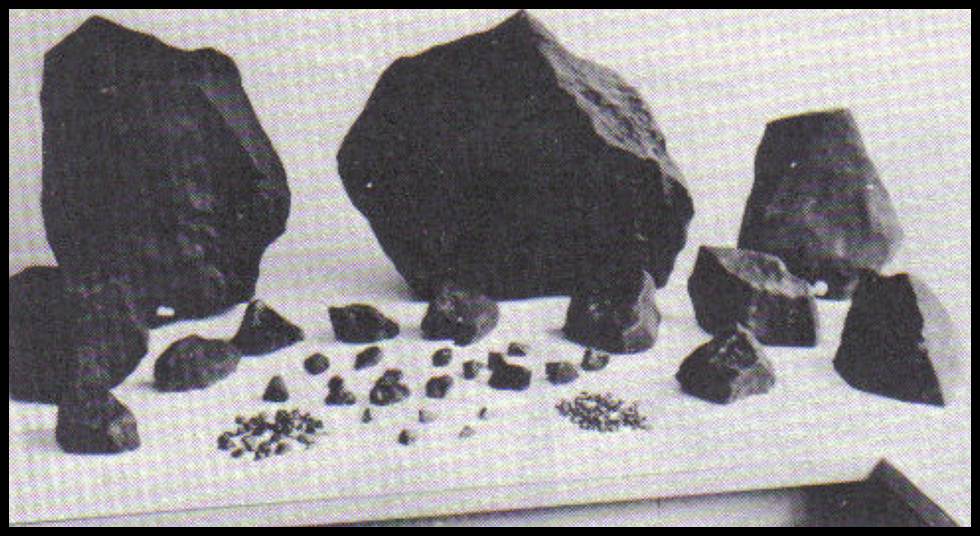Bruderheim Reaches for the Stars with its Identity Symbol!The Town of Bruderheim is proud of its identity symbol, the Bruderheim Meteorite, a truly unique and scientifically important historic event. |
The story of our Meteorite
On March 4th, 1960 at 1:06 a.m., a bright fireball tore through Earth's atmosphere above Central Alberta. The space rock travelled at 42 kilometres per second, its flash witnessed by hundreds of people as far away as the Rocky Mountain region of British Columbia. The giant rock detonated, creating a sound shock wave audible over 5,000 square kilometres. The sonic boom rattled windows, shook the foundations of homes, and startled families from their sleep. Shards of the stone rained down just north of Bruderheim, some forming pits as deep as 30 centimetres, many rebounding off the frozen ground and landing on the snow.
Based on eye-witness reports, it is believed that the meteorite was first observed by Alexis Simon, a resident of the Paul’s Band Indian Reserve at Duffield, Alberta. He noted the north-easterly direction of the rock, its swift speed, and that it looked like it was giving off ‘flashes of fire’. He also described a rushing sound that resembled a high wind and lasted about 5 seconds after the fireball passed.
Once news broke that a meteorite had fallen, people came from all around to search by air and land for the dark stones on the snow. The first meteorite fragment was found by a local farmer, Nick Broda, in his barnyard.
Other local farmers found the fragments in their barnyards and fields, the largest weighing 66 pounds. One farmer was astounded to find meteorite fragments only a few feet from his front porch.
Other locals, including Stan Walker and Ty Balacko, were instrumental in mapping the fall area and for recovering fragments. In the days that followed, the two men recovered a total of 155 pounds of meteorite.
Andreas Bawel and Walter and Nick Holowaty of Bruderheim collected about 22 pounds of fragments on their farms. Walter Holowaty made the first collections off the ice on the North Saskatchewan River, digging down through the snow to the ice surface wherever he observed an impact hole.
Hundreds of grit- and pebble-sized fragments were collected off of river ice. Undoubtedly many thousands of small fragments were not seen against the black dirt of fields and plowed under as farmers prepared to seed their crops.
Nearly 700 meteorite fragments were found with a total weight of over 660 pounds—making it the largest recovered fall in Canadian history. Most pieces found were eventually acquired by the University of Alberta, some of which were later traded and distributed to museums and research facilities around the world.
A partial listing of places that have specimens of the Bruderheim Meteorite, as a result of exchanges with the University of Alberta Meteorite Collection, include:
- Smithsonian National Museum of Natural History, Washington, D.C.
- American Museum of Natural History, New York
- Peabody Museum, Yale University
- Redpath Museum, McGill University
- National Meteorite Collection, Ottawa
- The Vatican Meteorite Collection
- Department of Earth Sciences, Cambridge University
- Université de Montréal, Montréal, Quebec
|
You can see the Bruderheim Meteorite on display in the Bruderheim Fire Hall! Please call 780-796-3731 for more information. Photo credit: Archives, Dept. of Earth and Atmospheric Science, University of Alberta |
|
Why is the Bruderheim Meteorite so important?
The Bruderheim Meteorite is the largest recovered meteorite fall in Canadian history. It occurred at the onset of the ‘space age’—only three years prior, the Soviet Union launched Sputnik, the world’s first artificial Earth satellite that triggered the ‘space race’ between the Soviet Union and the United States. The Sputnik launch led directly to the creation of National Aeronautics and Space Administration (NASA), and spawned pioneering efforts to launch other artificial satellites, unmanned probes of the Moon, Venus, and Mars, and human spaceflight in low Earth orbit and to the Moon. As preparations began to accomplish these feats, the Bruderheim Meteorite provided scientists with valuable insight.
“The collection of Bruderheim meteorites and trades in the decades that followed are responsible for most of the growth of the University of Alberta Meteorite Collection into the largest University-based meteorite collection in Canada. And the collection still contains over 145 kg of Bruderheim meteorites!" (Dr. Chris Herd, University of Alberta)
Specimens of the Bruderheim Meteorite have yielded much information on the nature of radiation in space, the origin and nature of the solar system, and the universe. Data accumulated in the scientific literature suggests that the Bruderheim Meteorite may be one of the world’s most extensively studied chondritic meteorites.
Fast Facts about the Bruderheim Meteorite
|
What exactly is the Bruderheim Meteorite?
There are three types of meteorites: stony, iron, and stony-iron meteorites. The Bruderheim Meteorite is a stony meteorite of the chondrite variety.
Chondrite meteorites are very ancient. They formed during the birth of our solar system more than 4.5 billion years ago. They are made up of chondrules, which are round granular bits of minerals that were once molten and free floating in space. These droplets combined into a primitive asteroid that orbited the sun. At one point, the asteroid would have broken up, possibly due to a collision in space, and a smaller piece was set on a collision course with Earth.
Chondrites represent one of the oldest solid materials within our solar system and are believed to be the building blocks of the planetary system.
Most pieces of the Bruderheim Meteorite exhibit what is known as a ‘fusion crust’ —a dark and glassy coating caused by the meteor heating up as it passed through Earth’s atmosphere.

